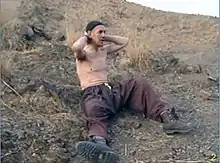Irek Hamidullin
Irek Ilgiz Hamidullin[1] (Russian: Ирек Хамидуллин) is a citizen of Russia, who the United States authorities report they captured in Afghanistan in 2009.[2][3][4] Hamidullah is said to be a nom de guerre of a Russian in his fifties, who, according to some, defected from the Soviet Armed Forces, occupying Afghanistan, in the 1980s. His real name is not known, nor how he spent the decades between his defection from the Soviet Union and his capture by U.S. forces, although American officials have said they believe he participated in "several" attacks on U.S. forces. It is known that he was recovering from wounds, when captured.
Irek Hamidullin | |
|---|---|
 Irek Hamidullin when he was captured on November 29, 2009 | |
| Born | Naberezhnye Chelny, Tatarstan, Russia |
| Nationality | Russian |
| Known for | Held in extrajudicial detention by the USA |
| Criminal charges | Material support, attempted murder of U.S. military personnel, conspiracy to use a weapon of mass destruction and possession of a firearm in connection with a crime of violence. |
| Criminal penalty | Life imprisonment plus 30 years |
| Criminal status | Incarcerated at ADX Florence |
According to a 2004 report in the Moskovsky Komsomolets, Irek Hamidullin graduated from a Suvorov Military School in Kazan, and a tank officer training college in Leningrad. He left the Soviet Army in 1989, and became a businessman in Tatarstan's Naberezhnye Chelny, selling car parts. In 1996–98 he studied at a local madrasa named Yoldyz ("Star"), which was viewed by the local authorities as Wahhabi-influenced. He went to Chechnya in 1998–99, but became disappointed with the Chechens, as, in his view, they failed to follow the Shariah law. After returning to Tatarstan, he started looking for a place where Shariah is obeyed, and later in 1999 he went to Afghanistan with a group of like-minded Tatar Muslims.[5]
In 2003, he was detained in Pakistan, accused of illegal crossing of the Afghanistan–Pakistan border, and spent around half a year in detention. After his release, he flew to Russia on April 15, 2004. He was interviewed by Russia's FSB, but no charges were laid; in the summer of 2004 it was reported that he was about to leave for Sudan.[5]
The Washington Post reported in December 2013 that Hamidullah was one of the several dozen long term captives held in the Bagram Theater Internment Facility who were not citizens of Afghanistan.[2]
The Washington Post reported the Hamidullah was considered one of the foreigners with the strongest evidence against him, and that the Department of Defense wanted to bring him to the United States, to face charges before a military commission like the controversial Guantanamo military commissions.[2] They reported the DoD was planning to try to bring less than ten foreign captives from Afghanistan to the United States to face charges before a military commission.[3] Quoting officials who would not put their name on record the Washington Post reported "He's pretty well-connected in the terrorist world," and that he had ties to Chechen rebels, and two Afghan opposition militias, and that he had declared he would "return to jihad," if released.
The U.S. Congress has restricted the U.S. President from bringing Guantanamo captives to U.S. territory—even those who had been determined not to have been enemy combatants, after all.[2][3] But Congress didn't consider the possibility that captives held outside of Guantanamo might be brought to the US, so the restriction does not apply to them. United States Senators Saxby Chambliss and Lindsey Graham argued, instead, that men like Hamidullah should be sent to Guantanamo.
Human rights scholars and legal experts questioned whether it was appropriate to charge these men before the troubled and largely unprecedented military commission system, when the United States had successfully prosecuted hundreds of terrorists in the regular U.S. civilian justice system.
Marty Lederman, a Professor at Georgetown University, writing in Just Security, in December 2013, pointed out that, without regard to the speculation over whether he should face charges before a Military Commission, no one had given any indication as to what crime he had committed.[4]
References
- "Indictment". Archived from the original on 2020-10-30. Retrieved 2020-11-22.
-
Adam Goldman, Karen DeYoung (2013-12-17). "Military trial in U.S. being considered for Russian detained in Afghanistan". Washington Post. Archived from the original on 2014-02-26. Retrieved 2014-03-08.
The Russian is a veteran of the Soviet war in Afghanistan in the 1980s who deserted and ended up fighting U.S. forces after the Sept. 11, 2001, attacks. U.S. officials said the man, thought to be in his mid- to late 50s, is suspected of involvement in several 2009 attacks in which U.S. troops were wounded or killed. He was wounded during an assault on an Afghan border post that year and later captured.
-
Adam Goldman (2014-02-25). "U.S. quietly whittles down foreign detainee population at facility in Afghanistan". Washington Post. Archived from the original on 2014-03-03. Retrieved 2014-03-08.
Among the best candidates, officials say, is a Russian who was captured several years ago. He is suspected of participating in insurgent attacks in Afghanistan in 2009. Officials say Brig. Gen. Mark Martins, the chief military prosecutor, is eager to prosecute the Russian, whose nom de guerre is Irek Hamidullan.
-
Marty Lederman (2013-12-18). "What We Don't Know About Irek Hamidullan". Just Security. Archived from the original on 2014-11-26. Retrieved 2014-11-26.
One other (completely speculative) possibility: The alleged conduct in question might be both a war crime and a title 18 offense, but it could be that some of that critical evidence is either hearsay or voluntary-but-unsworn custodial statements of the accused that would be inadmissible in an article III trial.
- Metelyova, Svetlana (Светлана Метелёва) (2004-07-28), "Живи и дай умереть другим (Live and let others die)", Moskovsky Komsomolets, archived from the original on 2016-03-04, retrieved 2015-08-11